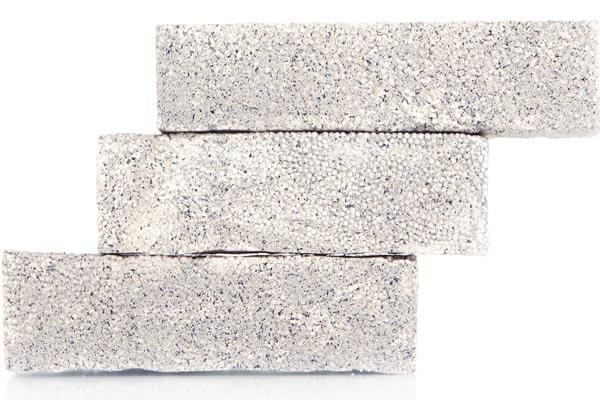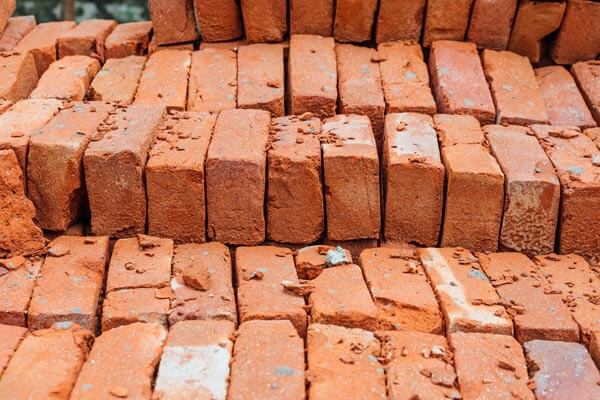Bricks are a very important part of constructing homes, structures, or other kinds of infrastructure. Along with bricks, we need other materials like soil and sand to complete a building. We need to be aware of the different kinds of bricks that can provide stability and safety in construction because of their strength, adaptability, and insulation. Bricks are also beneficial for sustainable architecture since they can be recycled and reused. They remain very important for building and have been used for centuries to create the world’s architecture.
41 Types of Brick You Should Know

Image Source: Freepik
This article will look at different types of bricks used in modern construction. We will learn about the different qualities and advantages of classic clay bricks, concrete bricks, and firebricks that are used for specific purposes. Keep reading to find out more!
Brick & Its History
Bricks are rectangular building materials made from shale or clay that are heated in a kiln. They have been used since ancient times when the Sumerians first started making fired bricks around 3000 BC. Bricks have been an important part of architecture because they are so versatile, provide insulation, and last a long time. Over the centuries, bricks have been used in many different structures, from ancient buildings to modern ones. The use of bricks increased during the Industrial Revolution due to advancements in technology.
Types of Bricks
We have made a list of the main groups that bricks are divided into. Here is the list:
Based on Raw Materials
Bricks are divided into different categories based on what materials were used to make them. Here are the main ones.
Clay Bricks

Image Source: Freepik
Clay bricks are a very common and traditional type of brick that is heated in a kiln and made from clay. Different types of clay bricks exist due to the different properties and colors of the clay.
Concrete Bricks

Image Source: Freepik
Concrete bricks are commonly used for building purposes. They are made up of a mix of water, aggregate, sand, and cement, and can be made in various colors and textures. Additionally, these bricks are great for walls, fences, and other external structures due to their heat-resistance and sound-reducing qualities.
Sand-Lime Bricks

Image Source: Freepik
Sand-lime bricks are made by combining water, lime, sand, and fly ash and pressing them together. The reaction between the silica and lime gives these bricks a greyish color with a uniform, smoother look than clay bricks. This makes them strong enough to be used as load-bearing members and they don’t need to be plastered.
Fly Ash Bricks

Image Source: Freepik
Fly ash bricks are an environmentally friendly option that uses fly ash, a waste material from burning coal. These bricks provide good insulation and don’t require as much energy to produce. When they get wet, they swell up and are less permeable than clay bricks, so they don’t need to be plastered, providing a smooth finish.
Refractory Bricks

Image Source: Freepik
Fire bricks are great if you need bricks that can handle extreme heat. They are called refractory bricks and are specially made from soil that will not change shape, size, or strength when heated up. These bricks are perfect for places like furnaces and chimneys that have a lot of heat and pressure.
Engineering Bricks

Image Source: Freepik
Engineering bricks are special types of bricks made from hard clay or shale. They are very strong and are often used in places that need extra stability.
Based on the Building Process
Here is a division of different kinds of bricks based on how they are used for construction:
Unburnt Bricks

Image Source: Freepik
These bricks are called “half-burnt” because they are weaker and yellow in color. They are used as filling for basement foundations or as a base for concrete and lime terraces. It’s important to remember not to let these bricks get wet from rain.
Burnt Bricks

Image Source: Freepik
Burnt bricks, also known as fired bricks, are created by heating up clay-based materials in a furnace or oven at very high temperatures. This changes the clay’s chemical and physical properties, making it strong and durable enough to be used for construction. They are great for building because of their heat resistance, durability, and strength.
Over Burnt or Jhama Brick

Image Source: Freepik
Overburnt bricks, also called Jhama bricks, are fired at very high temperatures for a longer period of time than regular bricks. This makes them misshapen, but it gives them more strength and makes them more absorbent, so they are often used in foundations with lime concrete. Their strength is the same as first-class bricks, but they are better at absorbing things.
Based on the Manufacturing Method
The way bricks are made determines what type of brick they are. Here’s how they are categorized:
Extruded Bricks

Image Source: Freepik
Extruded bricks are created by pushing clay through a shaped mold using a machine. These bricks are the same size and shape, making them a good option for use in modern buildings, especially those on a tight budget.
Molded Bricks

Image Source: Freepik
Bricks that are molded come in different sizes and forms and are created by putting clay into molds. They are not made in a machine but are instead made by hand in the molds, and often have a rustic or classic look.
Dry-Pressed Bricks

Image Source: Freepik
Dry-pressed bricks are hard and strong bricks made by using a special machine to press clay with little water into shapes.
Based on Shape

Image Source: Freepik
The shape of the brick used depends on what the structure needs, the type of architecture, and the look that is desired. Below is a list of the types of brick based on their shape.
Bullnose Brick
Bricks that are shaped in a curved form are called bullnose bricks, often used to make curved corners.
Airbricks
Airbricks are special bricks with holes in them that allow air to flow through. They are used in walls with a cavity and on suspended floors.
Channel Bricks
Bricks formed into a gutter-like shape are called channel bricks and are used for drains.
Coping Bricks
The shape of the coping bricks on a wall depends on how thick the wall is. The possible shapes are angled saddleback, chamfered, or half-
Cow Nose Bricks
These bricks are called “cow nose” because they are shaped like a cow’s nose.
Capping Bricks
The bricks used to cover the top of walls not connected to a building are called capping bricks.
Brick Veneers
Brick veneers are used to cover walls and they are usually thin.
Curved Sector Bricks
Bricks that are used for paving, arches, and other places that require a curved shape are known as curved sector bricks.
Hollow Bricks
Hollow bricks are also known as cavity or cellular bricks. They are much lighter than regular bricks – only one-third of the weight – and are usually 20 to 25 mm thick. Laying them is a lot quicker than regular bricks, so construction can be completed faster. They are also often used for partitioning.
Paving Bricks
Paving bricks contain a good amount of iron which helps them stay strong even when fired at lower temperatures. This makes them perfect to use in paving roads and garden park floors as they are able to handle the wear and tear from traffic. Additionally, they are less slippery so it is safer to walk on.
Perforated Bricks
Perforated bricks are named this way because they have holes in them in a cylindrical shape. They are very light and easy to make, using less clay than other types of bricks. They come in different shapes, like square, rectangular, or round. They are used in the construction of lightweight structures and multi-story frame structures.
Based on Size

Image Source: Freepik
Bricks are available in various sizes to fit different building plans and requirements. Here are some of the most common sizes of bricks
Standard Bricks
One of the most common bricks for construction is the standard bricks which fit well in most wall patterns and are versatile. These bricks come with dimensions of about 3 5/8 inches by 2 ¼ inches by 8 inches.
Modular Bricks
Modular bricks are slightly larger than regular bricks, measuring 3 5/8 inches by 2 ¾ inches by 7 5/8 inches. Due to their size, they make building easier and more efficient.
Jumbo Bricks
Jumbo bricks are very big, measuring about 3 5/8 inches by 3 5/8 inches by 11 5/8 inches. They help build things faster and require less mortar because of their size.
Queen Bricks
Queen bricks are slightly smaller than regular bricks, measuring about 3 1/8 inches by 2 ¾ inches by 7 5/8 inches. If you want an attractive look for your home, they are the ideal choice. Knowing the construction needs, design taste, and structural needs helps to choose the right size of queen bricks. Different sizes of these bricks provide different functional and aesthetic advantages.
Based on Quality

Image Source: Freepik
You can group bricks according to their strength and Quality. Here is a list of the various types of bricks depending on Quality
First Class Bricks
First-class bricks are all the same size, shape, and color and are of very good quality. They have no bumps or imperfections and have consistent texture, making them perfect for use in parts of a building that are visible.
Second Class Bricks
Second-class bricks are not as good quality as first-class bricks. They may be a bit uneven, but they can still be used for building walls.
Third Class Bricks
Third-class bricks are not the same shape, have cracks and imperfections, and are mainly used in walls that don’t have to bear weight.
Based on Use

Image Source: Freepik
Here is another classification of different types of bricks based on their specific use in construction. Here is the list of some of the standard brick types based on their intended purpose of use
Common Bricks
The bricks usually used in buildings are called common bricks. They can be used for making walls that hold weight or walls that don’t hold weight. These bricks are not very strong, not of great quality, and not very resistant.
Engineering Bricks
Engineering bricks are often used when a structure needs to be strong and stable, like in foundations and walls. They have a high amount of strength and they are dense, which helps them stay strong. They are also resistant to chemicals and have a good amount of load-bearing capacity. They come in three different classes, A, B, and C, with class B being the most common. However, class A is the strongest of the three.
Based on Location

Image Source: Freepik
This is a list of various kinds of bricks that are grouped together based on where they are located.
Cream City Bricks
The bricks in this place come from Milwaukee, Wisconsin.
London Stock
These bricks are used in London.
Dutch
These bricks are from Holland.
Nanak Shahi Bricks
These bricks are made in India.
Roman
These bricks were used in buildings made by the Romans.
Staffordshire Blue Brick
These bricks are made in England.
Based on Weather Resisting Capability

Image Source: Freepik
Below is a list of various types of bricks, categorized based on how well they can withstand different types of weather.
Severe Weather Grade
Bricks with a high weather rating are used in areas that have snow for a lot of the year because they can handle freezing and thawing.
Moderate Weather Grade
Moderate weather-grade bricks are ideal for use in tropical climates as they can withstand high temperatures. These bricks are commonly used in countries with a warm climate and are an affordable, durable building material.
No Weather Grade
No-weather grade bricks are used inside walls because they cannot withstand bad weather.
Some Interesting Facts About Bricks:
Bricks have a really interesting past and some cool facts! Here are a few facts about bricks that you might find interesting:
- People have been using bricks to build things for thousands of years. The first known use of bricks is from around 7500 BC in modern-day Turkey.
- Bricks are known for being very strong and durable, which is seen in the Great Wall of China and Roman aqueducts.
- Bricks help keep the indoor temperature comfortable by not needing as much heating and cooling because they are good at keeping in heat.
- Bricks are made with lots of renewable materials, like clay, meaning they are good for the environment and don’t create a lot of carbon emissions.
- Bricks are a good option for buildings in areas prone to fires due to their composition and the way they are made, which makes them very resistant to fire.
- The color of bricks varies based on the type of clay and how they are fired. This allows for many different options when it comes to creating unique architectural designs.
- Bricks come in different shapes and sizes, so you can pick the best ones for your building project.
- Bricks are not just used for building, but they can show what type of architecture is popular in certain areas and can have a lot of meaning for a place, both culturally and historically.
- Skilled bricklayers can make buildings look more creative and interesting by adding patterns, designs, and textures.
To sum it up, there are a lot of different types of bricks to choose from for construction purposes. Bricks have been used for building since ancient times, and are still very popular today. This article has helped you learn more about different types of bricks. Let us know if it is helpful for you!
Read More:



